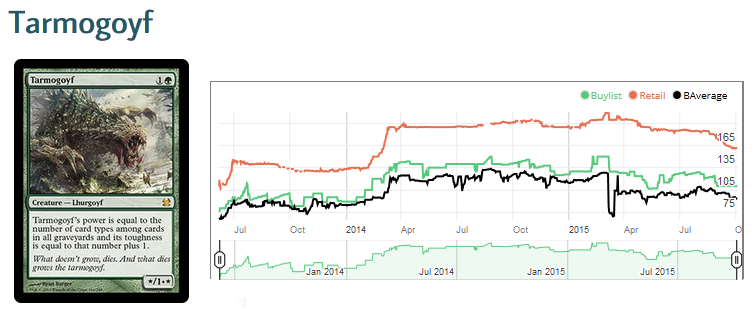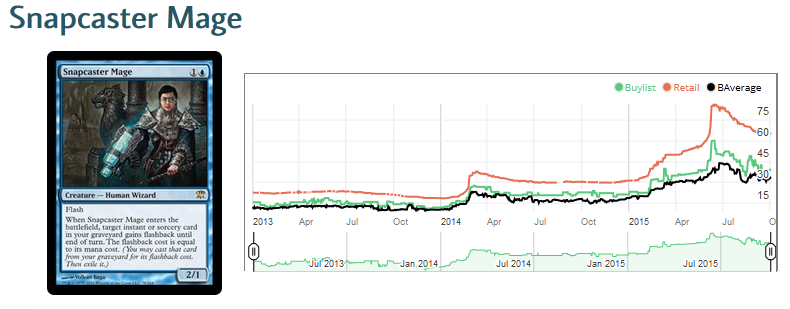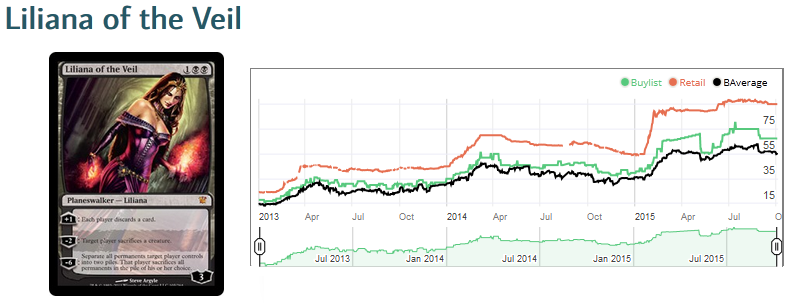Are you a Quiet Speculation member?
If not, now is a perfect time to join up! Our powerful tools, breaking-news analysis, and exclusive Discord channel will make sure you stay up to date and ahead of the curve.
Tarmogoyf's price tag is one of the scariest barriers to Modern entry. You can add a few others to that daunting list: Snapcaster Mage, Liliana of the Veil, and even the Zendikar block fetchlands. Staples like these are widely played in Modern's top-tier decks and they have the dollar value to prove it.
Although there are plenty of decent Modern decks that don't use these cards (Affinity, R/G Tron, Amulet Bloom, etc.), the biggest Modern names all require Goyf and company. This can be intimidating to players who are hesitant to spend hundreds of dollars on a few pieces of cardboard.
Big bucks for a bunch of paper
I know plenty of Modern players who get by just fine without these cards. Unfortunately, this means they also need to get by without some of Modern's best decks. Want to play Jund or Abzan? Better be willing to fork up $700+ on some just the Lilys and the Tarmogoyfs. That doesn't even count the lands! Interested in Twin variants, Grixis Control, or Burn? They aren't quite as steep as the BGx decks, but you'll still need to shell out a chunk of change to sleeve up their cores and manabases.
We're still in the Modern off-season, which means it's a perfect time to talk about buying into Modern's costliest staples. You don't need these cards to succeed in Modern, but it never hurts to have your Jund or U/R Twin boxed up and ready to go if you can't figure out what else to play in a metagame.
Today, we'll go over how to time your purchase around metagame and market cycles so you aren't spending more than you have to on three of Modern's most expensive cards.
Tarmogoyf: Modern's Posterchild
When Wizards announced Modern Masters back in 2012, it was no coincidence that Tarmogoyf was the first spoiler.
Modern's not-so-jolly green giant was always one of the format's most expensive cards, and also one of its most-played. BGx decks use it, Zoo decks use it, Temur Twin decks splash for it: Goyf is the benchmark by which other Modern creatures are judged, and that's reflected in its price tag.
If you want to play any of those decks mentioned above or any of their versions, you'll need your Tarmogoyf playset. And if you need your Goyf playset, that means you'll need $600 or more just for the creature alone. You'll need more than that if you want the (superior) Future Sight art!
What's a prospective BGx or Zoo player to do?
One option, both with Goyf and all the other cards we'll talk about today, is to wait for a downturn in the metagame cycle. This means holding out until one of Goyf's many decks becomes less viable, either due to a new competing card, a banning, a breakout deck seizing the spotlight, etc.. Lower format shares for BGx, Zoo, and Temur Twin might mean lower Goyf stock, as players sell off their Goyfs and migrate to other decks.
Unfortunately, this doesn't happen in practice:
 Since 2014, Tarmogoyf's price has shown remarkable stability, weathering a huge metagame downturn during the Treasure Cruise and Birthing Pod winter of late 2014. Despite Delver and Pod decks dominating the format, with few Temur decks to buoy the card's value, price memory held on tight and Goyf kept its $150+ throne. Siege Rhino's prominence in Abzan decks helped keep Goyf afloat, but the overall metagame outlook was bleak for the Lhurgoyf.
Since 2014, Tarmogoyf's price has shown remarkable stability, weathering a huge metagame downturn during the Treasure Cruise and Birthing Pod winter of late 2014. Despite Delver and Pod decks dominating the format, with few Temur decks to buoy the card's value, price memory held on tight and Goyf kept its $150+ throne. Siege Rhino's prominence in Abzan decks helped keep Goyf afloat, but the overall metagame outlook was bleak for the Lhurgoyf.
And yet, Goyf's price stayed high, never dropping below ~$160.
What about market downturns? Metagame shifts might not cut it, but surely a mass reprinting could affect the price, or even the printing of a new card to compete with Goyf. Not with Goyf. Neither a Modern Masters 2015 reprint nor the rise of Tasigur, the Golden Fang could dent Goyf's price tag. The best even the reprinting could do was a $20 or so drop, but no one is calling $150 "cheap".
Given Goyf's history and outlook, when exactly is the best time to get in on Modern's best green creature?
As much as it pains me to say it, the answer is "sooner rather than later". Unlike some cards, Goyf isn't really a staple you can sneak into. Between the continued relevance of Goyf in BGx and Zoo/Temur decks, its profile in Legacy, and the steady growth Modern experiences as a format, there will never be a time where Goyf's stock is going to crash. A huge reprint might do this, or a reprint at rare, but Wizards has given no indication this is in their longterm Modern plans.
Ever want to play Goyf in Modern? Buy it now. This card is never going down, especially if Wizards continues an every-other-year Modern Masters cycle, and especially if the format continues to enjoy popularity. I could see Goyf's price retreating on a 2-3 year timeline, but that's way too long for most Modern entrants to think about. If you want your Goyfs for the upcoming November tournaments, you just need to bite the bullet and buy your Goyfs as soon as you can.
Snapcaster Mage: The Format's "Best" Card
Earlier this summer, at GP Charlotte, a number of pro players gave their opinions about the best cards in the format. Most of them agreed that the hand's-down winner was Snapcaster Mage. Tiago Chan's invitational card is the defining blue force in Modern, almost singlehandedly allowing blue mages to compete in a format that would otherwise be dominated by BGx and linear strategies.
You sometimes hear Modern players complain that you actually can't play green in Modern without playing Tarmogoyf. That's not close to true. Elves, Abzan Pod, Abzan Liege, Amulet Bloom, Scapeshift, R/G Tron, and a huge range of other Tier 1 or Tier 2 decks stand as clear counterexamples to this theory. You can even play aggro without playing Goyf: just look at Merfolk, Affinity, and Burn to see that in action.
The same is not true of Snapcaster and blue. If you want to play a controlling blue deck in Modern, you really do need Tiago in your 75. Grixis Control and the control-in-disguise Twin decks both illustrate this phenomenon. The Delver decks, Jeskai Control and Midrange, and Scapeshift also count Snapcaster on their roster, as do fringe strategies like 4C Gifts, Esper Control, and many U/W Control variants.
Those Emeria, the Sky Ruin/Sun Titan control strategies are a bit of an exception here, but for the most part, Snapcaster is blue-based control in Modern.
Best friends with Snapcaster
From a price perspective, Snapcaster saw a a massive price increase when the Modern community internalized his exclusion from Modern Masters 2015. Making matters worse for Snapcaster buyers, Grixis Delver/Control strategies took off at around the same time, creating further pressure on Snapcaster's limited supply.
The end result was a $75.00 price high by the beginning of the summer, a spike only worsened by the Grixis success during GP Charlotte.
 Bad news: Snapcaster today is significantly more expensive than it was a year ago. This graph probably depresses you as much as it depresses me. Don't you just wish you picked up some Tiago's back in early 2014 when Deathrite Shaman got banned?
Bad news: Snapcaster today is significantly more expensive than it was a year ago. This graph probably depresses you as much as it depresses me. Don't you just wish you picked up some Tiago's back in early 2014 when Deathrite Shaman got banned?
Good news: Snappy's price has dropped a lot since June and now is a great time to buy into Modern's best card.
After a promising start in June, Grixis decks took a huge hit in August and September. As I (and other authors) wrote about on Modern Nexus, we saw steady shifts away from Grixis in Worlds, the SCG Opens, and at GP Oklahoma City as players overprepared to beat Grixis. Twin didn't do much better: as I discussed in an August metagame breakdown, the deck actually fell out of Tier 1 for the first time in years.
Worst enemies with Snapcaster
All of these metagame factors led to a major decline in Snapcaster's price, and a shining opportunity for enterprising Modern players to snag this iconic creature. I expect Snapcaster will continue to drop as we move through October and into November, so you don't need to pull the trigger on your Snapcaster purchase just yet. Off-season pre-trends tend to continue through the off-season, so there's no reason to believe Snapcaster will suddenly experience a price reversal before late November.
Like Goyf, Snapcaster is a card that is always relevant and gets better with new sets. Unlike Goyf, Snapcaster is undervalued now relative to what it is likely to become next year. Snapcaster also benefits from new sets and cards much more than Goyf.
Just like how Birthing Pod got better with every new creature printed, so too does Snapcaster improve with every new instant and sorcery, or even just URx-colored card benefiting his various shells. At this point, it's only a matter of time until the next Kolaghan's Command.
Whether you get your Snapcasters now or get them in November, don't wait longer than that: this card is bound to go up again in the new year.
Liliana of the Veil: The Queen of BGx
First Tarmogoyf and now Liliana of the Veil: black-green decks get all the love in today's article. That should make sense to anyone who has bought the deck before, or at least looked at its cost. Jund and Abzan are easily the most expensive decks in Modern, and Queen Lily is a big contributor to those price-tags.
Compared to Snapcaster and Tarmogoyf, Liliana sees less play in Modern's overall Tier 1 decks. Outside of Jund and Abzan, you won't see a lot of Innistrad's leading lady. At least buying Tarmogoyf lets you switch between the BGx Midrange decks and more aggressive options like Zoo.
Lily? It's BGx or bust for her. A notable exception to this is Michael Majors' techy Grixis list from the SCG Charlotte Open, but she's definitely no regular in Grixis colors.
Unfortunately for anyone who wants to sleeve up those Lilianas, she still commands a hefty price tag, despite her relative absence from Tier 1 decks.
Liliana illustrates an important Modern rule that you also see with Goyf: never bet against BGx. The BGx core has survived two bannings and numerous metagame shifts, and its staple cards will always hold value in even the most midrange-hostile metagames.
We certainly see more demand for Goyf than for Liliana, but she has enough players to hold a $75 price tag and a price history that never saw her drop value.
 Another depressing graph that makes me unhappy for not buying a hundred Lilianas back in early 2013. Liliana's price history closely mirrors metagame trends, and anyone who knows BGx's evolution in Modern can chart those alongside her rise.
Another depressing graph that makes me unhappy for not buying a hundred Lilianas back in early 2013. Liliana's price history closely mirrors metagame trends, and anyone who knows BGx's evolution in Modern can chart those alongside her rise.
Lily saw a slight uptick after Deathrite Shaman's 2014 banning when it became clear BGx would be just fine even without the one-mana planeswalker. She also held value throughout the Treasure Cruise era, even though the delve sorcery singlehandedly invalidated her best mode. This was followed by a huge spike in Abzan's February 2015 rise, and another jump when the Jund hype train was in full steam in early summer.
BGx's fortunes have risen and fallen from 2014 until today, but Lily's value has been eternal. This makes her, like Tarmogoyf before her, a steep purchase target that you won't be able to sneak in on. We'll never see a metagame where Lily is bad enough to drop her price: if Cruise-era Delver couldn't do it, nothing else will. Jund and Abzan will continue to see play and, as they do, players will continue to play Lily.
Never bet against BGx
For more wallet-conscious individuals, Liliana of the Veil doesn't need to be bought as a playset. Many BGx lists are running only three or even two of the planeswalkers in this aggressive metagame. This means you can get away with buying 2-3 of them if your bank account can't take another hit after getting that Goyf playset.
That said, there are metagames where four Lilianas are mandatory, so you might as well get them now before they go up any more.
The Reprint Question
As Ryan Overturf discussed in an excellent article last week, it's important to consider Duel and Event Deck reprints when buying into these kind of staples. He even had a few words about Tarmogoyf, using the beat-stick as an example of high-price cards that virtually guarantee their own reprinting. These considerations are also at play in Snapcaster, Lily, and any other expensive card you have your eyes on.
I expect all three of these cards to be reprinted in Modern Masters 2017. If that seems far away that's because, well, it is far away: Wizards seems locked into a two-year MM release cycle and there's no indication that this will change.
I could see a card like Liliana reprinted in a Duel Deck before then, especially a Modern-themed one, but Goyf seems like the kind of card that's reserved for Modern Master's print runs. Besides, you can always just play Scavenging Ooze to prey on those Goyf-dependent players.
As for Snapcaster, this is a strong Event Deck contender. I could see Wizards releasing some decks like this around the Modern Pro Tour next February, and Snapcaster would be a great inclusion for a Grixis or Jeskai-lite Control deck.
It's a great time to buy into Modern cards, and I'm excited to hear your own stories of off-season Modern investment. Any cards you think are good pickups? Any price analysis on Goyf, Snapcaster, or Lily that you think I missed? Let me know in the comments and I'll see you all next week!






I don’t think you need to put quotes around calling Snapcaster Mage the best card in Modern. ;P
Great article though.
Haha yeah, probably don’t need that one in quotes. But hey, there’s always the guys who think the best card is something like Bloom, Griselbrand, or whatever other pet/broken card they love!
Glad you enjoyed it! Let me know if there’s any Modern finance-related topics you’d want to see.
This is just me spitballing here, but a lot of people talk about approaching a new format by buying a cheaper deck in the format and winning your way to owning the deck you actually want to play. It would be interesting to see something written comparing the merits of saving up and buying in versus trying to win your way in with a budget option.
So when do you think is the best time for modern cards in general? not just major cards like goyf, but cards like Serum Visions, Inkmoth Nexus, Vendilion Clique, Splinter Twin, and inquisition of kozilek? Do you think they will go down further than this? or should I snap up $7 Visions and $20 Nexus?